Summary
Entamoeba histolytica is an intestinal parasite that is located in the lumen of the human intestine and can attack the epithelium. Antimicrobial peptides (AMPs) are effective against the wide range of microorganisms, such as bacteria, fungi, viruses, yeasts, and protozoa. The CM11 is a chimeric peptide that is derived from bee venom and butterfly compounds. In this study, the cytotoxic effect of CM11 on Human colonic carcinoma (Caco‑2) cells and E. histolytica were assayed in various concentrations of peptide and metronidazole. The MTT results showed that the highest percentage of cytotoxicity on Caco‑2 cells was in 24 μg/ml of CM11 peptide at 24 h and 48 h, which was 49.8%, and 44.3%, respectively. In the metronidazole group, the highest cytotoxicity with 40 μg/ml concentration was observed after 24 h and 48 h, with 43.5%, and 42.1%, respectively. The highest rate of apoptosis induced by CM11 on Caco‑2 was 53.9% and 51.4% after 24 h and 48 h, respectively; however, these rates were 19.1% and 33.4% in the metronidazole group. The effect of peptide and metronidazole on E. histolytica at 24 h and 48 h showed that at the highest concentration of CM11 peptide (24 μg/ml) the cytotoxic effect was 93.7% and 94.9% and for metronidazole (40 μg/ml) was 65.5% and 74.3%, respectively. In coculture, 63.5% and 57.7% of parasites were killed in the highest concentration of CM11 and metronidazole, respectively. The results of this study revealed that CM11 peptide has a high toxicity on E. histolytica, and the use of antimicrobial peptides in the future can be considered as anti-amoebic compounds.



Similar content being viewed by others
References
Lozano R, Naghavi M, Foreman K, Lim S, Shibuya K, Aboyans V, et al. Global and regional mortality from 235 causes of death for 20 age groups in 1990 and 2010: a systematic analysis for the Global Burden of Disease Study 2010. Lancet. 2012;380:2095–128.
Espinosa-Cantellano M, Martínez-Palomo A. Pathogenesis of intestinal amebiasis: from molecules to disease. Clin Microbiol Rev. 2000;13:318–31.
Turkeltaub JA, McCarty TR, Hotez PJ. The intestinal protozoa: Emerging impact on global health and development. Curr Opin Gastroenterol. 2015;31:38–44.
Calzada F, Yépez-Mulia L, Aguilar A. In vitro susceptibility of Entamoeba histolytica and Giardia lamblia to plants used in Mexican traditional medicine for the treatment of gastrointestinal disorders. J Ethnopharmacol. 2006;108:367–70.
Petri WA Jr, Haque R, Mondal D, Karim A, Molla IH, Rahim A, et al. Prospective case-control study of the association between common enteric protozoal parasites and diarrhea in Bangladesh. Clin Infect Dis. 2009;48:1191–7.
Townson SM, Boreham PFL, Upcroft P, Upcroft JA. Resistance to the nitroheterocyclic drugs. Acta Trop. 1994;56:173–94.
Elizondo G, Gonsebatt ME, Salazar AM, Lares I, Santiago P, Herrera J, et al. Genotoxic effects of metronidazole. Mutat Res Genet Toxicol. 1996;370:75–80.
Bendesky A, Menéndez D, Ostrosky-Wegman P. Is metronidazole carcinogenic? Mutat Res Rev Mutat Res. 2002;511:133–44.
Li Y, Xiang Q, Zhang Q, Huang Y, Su Z. Overview on the recent study of antimicrobial peptides: origins, functions, relative mechanisms and application. Peptides. 2012;37:207–15.
Altincicek B, Linder M, Linder D, Preissner KT, Vilcinskas A. Microbial metalloproteinases mediate sensing of invading pathogens and activate innate immune responses in the lepidopteran model host Galleria mellonella. Infect Immun. 2007;75:175–83.
Zhao X, Wu H, Lu H, Li G, Huang QLAMP. A database linking antimicrobial Peptides. PLoS ONE. 2013;8:e66557.
Chan DI, Prenner EJ, Vogel HJ. Tryptophan-and arginine-rich antimicrobial peptides: structures and mechanisms of action. Biochim Biophys Acta. 2006;1758:1184–202.
Otvos L Jr. Antibacterial peptides and proteins with multiple cellular targets. J Pept Sci. 2005;11:697–706.
Maróti G, Kereszt A, Kondorosi E, Mergaert P. Natural roles of antimicrobial peptides in microbes, plants and animals. Res Microbiol. 2011;162:363–74.
Mihajlovic M, Lazaridis T. Antimicrobial peptides bind more strongly to membrane pores. Biochim Biophys Acta. 2010;1798:1494–502.
Palm C, Netzereab S, Hällbrink M. Quantitatively determined uptake of cell-penetrating peptides in non-mammalian cells with an evaluation of degradation and antimicrobial effects. Peptides. 2006;27:1710–6.
Habermann E. Bee and wasp venoms. Science. 1972;177:314–22.
Steiner H, Hultmark D, Engström Å, Bennich H, Boman HG. Sequence and specificity of two antibacterial proteins involved in insect immunity. Nature. 1981;292:246–8.
Moore AJ, Beazley WD, Bibby MC, Devine DA. Antimicrobial activity of cecropins. J Antimicrob Chemother. 1996;37:1077–89.
Sengupta D, Leontiadou H, Mark AE, Marrink S‑J. Toroidal pores formed by antimicrobial peptides show significant disorder. Biochim Biophys Acta. 2008;1778:2308–17.
Melo MN, Ferre R, Castanho MARB. Antimicrobial peptides: Linking partition, activity and high membrane-bound concentrations. Nat Rev Microbiol. 2009;7:245–50.
Efimova SS, Schagina LV, Ostroumova OS. Channel-forming activity of cecropins in lipid bilayers: effect of agents modifying the membrane dipole potential. Langmuir. 2014;30:7884–92.
Raghuraman H, Chattopadhyay A. Cholesterol inhibits the lytic activity of melittin in erythrocytes. Chem Phys Lipids. 2005;134:183–9.
Bland JM, De Lucca AJ. Identification of cecropin A proteolytic cleavage sites resulting from Aspergillus flavus extracellular protease(s). J Agric Food Chem. 1998;46:5324–7.
Giacometti A, Cirioni O, Kamysz W, D’Amato G, Silvestri C, Del Prete MS, et al. Comparative activities of cecropin A, melittin, and cecropin A‑melittin peptide CA(1-7)M(2-9)NH2 against multidrug-resistant nosocomial isolates of Acinetobacter baumannii. Peptides. 2003;24:1315–8.
Yevtushenko DP, Romero R, Forward BS, Hancock RE, Kay WW, Misra S. Pathogen-induced expression of a cecropin A‑melittin antimicrobial peptide gene confers antifungal resistance in transgenic tobacco. J Exp Bot. 2005;56:1685–95.
Cavallarin L, Andreu D, San Segundo B. Cecropin A—derived peptides are potent inhibitors of fungal plant pathogens. Mol Plant Microbe Interact. 1998;11:218–27.
Badosa E, Ferre R, Planas M, Feliu L, Besalú E, Cabrefiga J, et al. A library of linear undecapeptides with bactericidal activity against phytopathogenic bacteria. Peptides. 2007;28:2276–85.
Que X, Reed L. Nucleotide sequence of a small subnit ribosomal RNA (16S-like rRNA) gene from Entamoeba histolytica: Differntiation of pathogenic from nonpathogenic isolates. Nucleic Acids Res. 1991;19:5438.
Robinson G. Laboratory cultivation of some human parasitic amoebae. Microbiology. 1968;53:69–79.
Diamond LS, Harlow DR, Cunnick CC. A new medium for the axenic cultivation of entamoeba histolytica and other entamoeba. Trans R Soc Trop Med Hyg. 1978;72:431–2.
Strober W. Trypan blue exclusion test of cell viability. Curr Protoc Immunol. 2015;111:A3‑B.
Dobiáš L, Černá M, Rössner P, Šrám R. Genotoxicity and carcinogenicity of metronidazole. Mutat Res Genet Toxicol. 1994;317:177–94.
Roe FJC. Toxicologic evaluation of metronidazole with particular reference to carcinogenic, mutagenic, and teratogenic potential. Surgery. 1983;93:158–64.
Bonin-Debs AL, Boche I, Gille H, Brinkmann U. Development of secreted proteins as biotherapeutic agents. Expert Opin Biol Ther. 2004;4:551–8.
Ranganathan S, Secretome GG. Clues into pathogen infection and clinical applications. Genome Med. 2009;1:113.
Leippe M, Andrä J, Nickel R, Tannich E, Muller-Eberhard HJ. Amoebapores, a family of membranolytic peptides from cytoplasmic granules of Entamoeba histolytica: isolation, primary structure, and pore bacterial cytoplasmic membranes. Mol Microbiol. 1994;14:895–904.
Leippe M, Andrä J, Müller-Eberhard HJ. Cytolytic and antibacterial activity of synthetic peptides derived from amoebapore, the pore-forming peptide of Entamoeba histolytica. Proc Natl Acad Sci Usa. 1994;29:2602–6.
Lai Y, Gallo RL. AMPed up immunity: how antimicrobial peptides have multiple roles in immune defense. Trends Immunol. 2009;30:131–41.
Steckbeck JD, Deslouches B, Montelaro RC. Antimicrobial peptides: new drugs for bad bugs? Expert Opin Biol Ther. 2014;14:11–4.
Moghaddam MM, Barjini KA, Ramandi MF, Amani J. Investigation of the antibacterial activity of a short cationic peptide against multidrug-resistant Klebsiella pneumoniae and Salmonella typhimurium strains and its cytotoxicity on eukaryotic cells. World J Microbiol Biotechnol. 2014;30:1533–40.
Zasloff M. Antimicrobial peptides of multicellular organisms. Nature. 2002;415:389.
Sand SL, Nissen-Meyer J, Sand O, Haug TM. Plantaricin A, a cationic peptide produced by Lactobacillus plantarum, permeabilizes eukaryotic cell membranes by a mechanism dependent on negative surface charge linked to glycosylated membrane proteins. Biochim Biophys Acta. 2013;1828:249–59.
Brauchle E, Thude S, Brucker SY, Schenke-Layland K. Cell death stages in single apoptotic and necrotic cells monitored by Raman microspectroscopy. Sci Rep. 2014;15:4698.
Matsuzaki K. Why and how are peptide-lipid interactions utilized for self-defense? Magainins and tachyplesins as archetypes. Biochim Biophys Acta. 1999;1462:1–10.
Cornick S, Chadee K. Entamoeba histolytica: Host parasite interactions at the colonic epithelium. Tissue Barriers. 2017;5:e1283386.
Rico-Mata R, De Leon-Rodriguez LM, Avila EE. Effect of antimicrobial peptides derived from human cathelicidin LL-37 on Entamoeba histolytica trophozoites. Exp Parasitol. 2013;133:300–6.
Ji S, Li W, Baloch AR, Wang M, Li H, Cao B, et al. Efficient biosynthesis of a Cecropin A‑melittin mutant in Bacillus subtilis WB700. Sci Rep. 2017;7:40587.
Funding
The study was supported by the Office of the Vice-Chancellor for Research and Technology, Faculty of Medical Sciences, Tarbiat Modares University, Parasitology and Entomology Department, Tehran, Iran.
Author information
Authors and Affiliations
Corresponding author
Ethics declarations
Conflict of interest
F. Mahdavi Abhari, M. Pirestani, and A. Dalimi declare that they have no competing interests.
Additional information
Publisher’s Note
Springer Nature remains neutral with regard to jurisdictional claims in published maps and institutional affiliations.
Rights and permissions
About this article
Cite this article
Mahdavi Abhari, F., Pirestani, M. & Dalimi, A. Anti-amoebic activity of a cecropin-melittin hybrid peptide (CM11) against trophozoites of Entamoeba histolytica. Wien Klin Wochenschr 131, 427–434 (2019). https://doi.org/10.1007/s00508-019-01540-9
Received:
Accepted:
Published:
Issue Date:
DOI: https://doi.org/10.1007/s00508-019-01540-9




